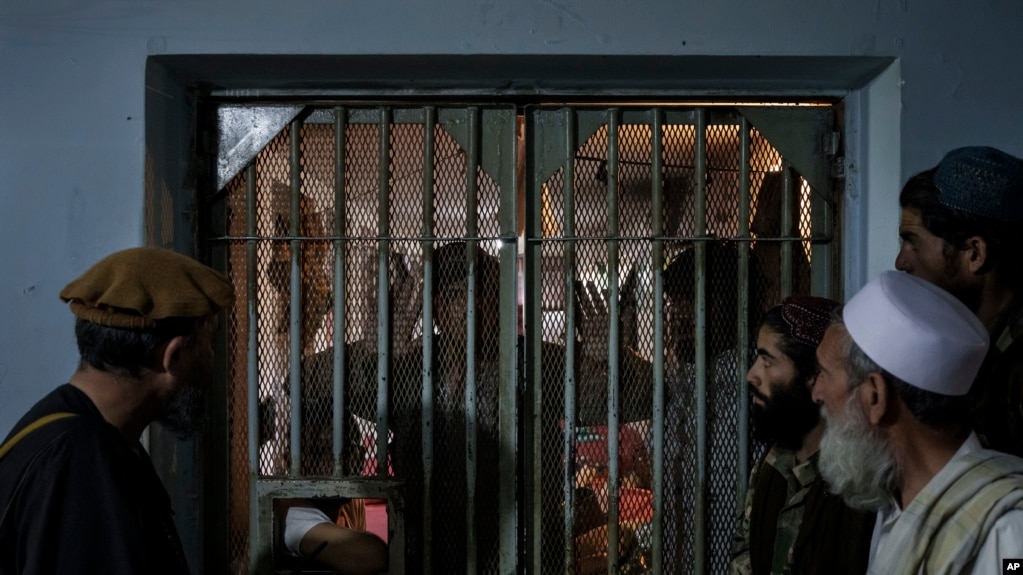Voice of America

Over the past 18 months, de facto Taliban authorities detained more than 29,000 individuals on various charges such as theft, kidnapping, murder and moral crimes according to country’s top prison official.
“We have released some 15,000 inmates,” Mohammad Yusuf Mistari, the Taliban’s director of prisons, told VOA in WhatsApp messages. “Currently, there are approximately 14,000 inmates in the Islamic Emirate’s jails.”
Among the prisoners, up to 1,100 are women.
Taliban officials claim they have no political prisoners and that all the prisoners are held on criminal charges — a claim not confirmed by independent organizations.
But groups like Human Rights watch say the Taliban have opted for killing criminals associated with armed opposition groups — Islamic State and other Afghan militias that have increasingly posed serious security threats to the fledging Islamist regime —instead of keeping them in jails.
Under the Islamic Emirate’s strict interpretation of Sharia, acts such as drinking alcohol or extramarital relationships are considered criminal and carry severe penalties, while homosexuality and sodomy are punishable by death.
Since November, the Taliban have restarted public displays of punishment. Thieves have had their hands chopped off, adulterers have been flogged, and those found guilty of murder have been shot and killed in front of hundreds of male spectators.
More than 100 men and women have been publicly whipped, and at least two men have been executed so far, according to the U.N. Assistance Mission in Afghanistan (UNAMA), which monitors human rights in the country.
“Such barbaric punishments — often carried out against persons for activities that should not even be considered crimes, such as listening to music — constitute torture or cruel, inhuman or degrading treatment, and are prohibited under international law,” Patricia Gossman, associate Asia director at Human Rights Watch, told VOA.
Redoing torture
Various forms of torture have been widely practiced at formal and informal detention centers and jails in Afghanistan, according to UNAMA and various rights groups.
Hundreds of Taliban fighters reportedly died in extremely brutal detention conditions in late 2001 and early 2002 during U.S.-led military campaigns that toppled the Taliban with the help of local Afghan militias, according to reports by the New York Times and Physicians for Human Rights.
Torture of detainees was also prevalent under the former Afghan government, which incarcerated more than 30,000 individuals, a large number of whom were alleged Taliban insurgents, according to U.N. reports dating back to at least 2011.
Last year, the Taliban produced a film documenting the bitter experiences of some prisoners held at the Parwan Detention Facility beside Bagram Air Base, which the U.S. military operated until 2012 when it was transferred to the Afghan government.
“The Taliban seem to be repeating all the mistakes and abuses of the past, including those they complained that the Republic [former Afghan government] had been responsible for, like torture,” Gossman said.
Mistari, the Taliban’s top official for prisons, refuted the torture allegations.
“Our leaders have given us a 39-articles guidance in which it’s said that we should treat inmates nicely,” he said, adding that the guidance also states if a guard or a jail official is seen taunting prisoners, he should be transferred elsewhere.
“We have nothing to do with their crimes. We are only there to protect the prisoners, feed them and keep them,” Mistari added.
Food, cold
Maintaining the prisons and feeding the large inmate population has long been a challenge in Afghanistan.
The previous Afghan government received financial and technical support from international donors to manage its prisons and detention facilities.
Facing strict international sanctions, the Taliban appears to be unable to run the jails, feed and care for the large inmate population.
Even outside the Taliban jails, an overwhelming majority of Afghans face hunger.
Millions of Afghans Facing Catastrophic Hunger
Throughout 2022, the International Committee of the Red Cross (ICRC) provided three meals daily for some 12,000 inmates in Afghanistan.
“The ICRC continues to work with Afghan authorities to ensure humane and dignified conditions of detention across Afghanistan,” Lucien Christen, an ICRC spokesperson, told VOA.
Moreover, the humanitarian organization has donated blankets, shawls, jackets and socks to keep 20,000 prisoners warm during the frigid winter temperatures.
Cold weather has killed more than 120 Afghans over the past two weeks, Taliban authorities have confirmed.
Both UNAMA and ICRC have access to prisons in Afghanistan for monitoring purposes.
“De facto authorities do appear to be seeking to fulfil their obligations in relation to the treatment of detainees,” UNAMA reported in July 2022. “Progress is hindered by financial constraints, resulting at times in inadequate food, medical care and hygiene supplies for detainees, and the cessation of vocational education and training programs for prisoners that were previously funded by the international community.”
Some senior Taliban leaders, including current ministers and governors, have a history of incarceration inside and outside Afghanistan, including at the Guantanamo Bay Detention Camp, a U.S. military prison set up in 2002 where only one Afghan inmate remains.
 Afghanistan Peace Campaign
Afghanistan Peace Campaign